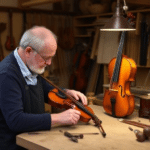Mastering the Art of Fingerstyle Guitar Playing: A Comprehensive Guide
Ever heard Tommy Emmanuel play guitar? The way he makes one instrument sound like a whole band is amazing. That’s the magic of fingerstyle guitar.
Fingerstyle is a way of playing guitar where you use your fingers instead of a pick to pluck the strings. It lets you play bass lines, melodies, and harmonies all at once. Learning fingerstyle gives you more freedom. It helps you create a unique sound. Plus, it is a lot of fun!
This guide is your roadmap to becoming a fingerstyle guitarist. We’ll cover the techniques, the exercises, and even what kind of guitar to use. Let’s get started!
Understanding the Fundamentals of Fingerstyle Guitar Technique
Fingerstyle is all about control. It means getting your hands in the right position. It’s about teaching your thumb to do its own thing. Let’s break it down.
Hand Positioning and Posture for Optimal Fingerstyle
How you hold your hands really matters. You want to be relaxed, not tense. Keep your wrist straight. Your fingers should curve naturally towards the strings.
Here is a quick checklist:
- Are your shoulders relaxed?
- Is your wrist straight?
- Are your fingers curved?
- Are you gripping too hard?
If you answered “no” to any of these, adjust your position. Good posture helps you play better and longer.
Developing Thumb Independence: The Foundation of Fingerstyle
Your thumb is the bass player in your fingerstyle band. It keeps the rhythm going. You need to train it to move independently. This lets your other fingers focus on the melody.
Try this exercise: Play an alternating bass pattern on the E and A strings. Use only your thumb. Once you get that down, try different patterns. Travis picking is a common pattern to experiment with. This helps build thumb strength and control.
Mastering Common Fingerstyle Patterns: Alternating Thumb, Travis Picking, and More
There are a few patterns that show up a lot in fingerstyle. The alternating thumb is one. Travis picking is another. With alternating thumb, your thumb switches between two bass notes. Travis picking adds a little more syncopation.
“Freight Train” by Elizabeth Cotten uses alternating thumb beautifully. “Nine Pound Hammer” is a great example of Travis picking. Learn these patterns. They’ll unlock a lot of songs.
Essential Fingerstyle Exercises and Drills
Exercises are important. They help you build the skills you need. Let’s look at some.
Dexterity and Coordination Exercises: Strengthening Your Fingers
You need your fingers to move independently. Spider crawls are great for this. Place your fingers on four frets in a row. Then, move them up and down the neck, one finger at a time.
Chromatic scales are helpful, too. Play every note in order up and down the neck. You can also adapt arpeggios for fingerstyle. These exercises build strength and coordination.
Timing and Rhythm Drills: Building a Solid Groove
Good timing is key. A metronome is your best friend here. Start slow. Play simple rhythms with your thumb. Then, add in your other fingers.
Try different rhythmic patterns. Practice syncopation. Play on the off-beats. This will make your playing more interesting.
Integrating Bass Lines and Melody: Creating a Harmonious Sound
The goal is to play bass lines and melody at the same time. Start with simple melodies. Play them over a consistent bass line. Practice until it feels natural.
Try playing “Mary Had a Little Lamb” over an alternating bass. It’s simple, but it teaches you the basics.
Choosing the Right Guitar and Gear for Fingerstyle
Your guitar matters. So does your gear. Let’s talk about what to look for.
Guitar Types: Acoustic, Classical, and Beyond
Acoustic guitars are popular for fingerstyle. So are classical guitars. Steel-string acoustics have a brighter sound. Nylon-string classical guitars are warmer.
String spacing is important. Wider spacing can be easier for fingerstyle. Neck width matters, too. Some guitars just feel better in your hands.
Some fingerstyle players love Martin guitars. Others prefer Taylor. Experiment to find what you like.
String Selection: Finding the Perfect Tone and Feel
Strings make a big difference. Nylon strings are easier on your fingers. Steel strings give you more volume.
String gauge matters, too. Lighter strings are easier to bend. Heavier strings give you more sustain.
Try different strings. See what sounds and feels best to you. Elixir and D’Addario are common brands.
Essential Accessories: Picks, Capos, and Amplification
You don’t need a pick for fingerstyle. However, some people use fingerpicks or thumb picks. These give you a brighter tone. They also add volume.
A capo can be helpful. It lets you change the key of a song easily. An amplifier can also be useful. Especially if you want to play live.
Learning Fingerstyle Repertoire: From Beginner to Advanced
Now, let’s talk about songs. Start with easier ones. Then, work your way up.
Beginner-Friendly Fingerstyle Songs and Arrangements
“House of the Rising Sun” is a good beginner song. “Dust in the Wind” is another. You can also find simplified versions of classical pieces.
These songs use basic fingerstyle techniques. They’ll help you build a foundation.
Intermediate Fingerstyle Pieces: Expanding Your Skills
Once you’re comfortable, try something harder. Pieces by Chet Atkins are great. Merle Travis is another good choice. John Renbourn is also worth exploring.
These artists use more complex fingerstyle patterns. They’ll challenge you to improve.
Advanced Fingerstyle Arrangements: Mastering Complex Techniques
For a real challenge, try Michael Hedges. Andy McKee is amazing, too. Tommy Emmanuel is a master.
These artists use advanced techniques. Harmonics, percussive hits, and complex arrangements are common.
Tips for Practice and Continued Improvement
Practice is key. Here are some tips to help you improve.
Setting Realistic Goals and Creating a Practice Schedule
Set small goals. Practice for 30 minutes a day. Focus on one skill at a time.
Break your practice into chunks. Warm-up exercises, learning new songs, and review of old material. A schedule helps you stay on track.
Developing Your Ear and Transcribing Music
Train your ear. Try to figure out songs by ear. This will improve your musicality.
There are ear-training apps. These can help you identify notes and chords. Transcribing music is a great skill to work on.
Joining a Community and Seeking Feedback
Connect with other guitarists. Join an online forum. Attend a workshop. Take lessons from a teacher.
Feedback is important. It helps you identify areas for improvement. Other guitarists can offer tips and support.
Conclusion
Mastering fingerstyle guitar takes time and effort. Focus on the fundamentals. Practice regularly. Choose the right gear. Learn from others.
Fingerstyle lets you express yourself in a unique way. Keep practicing. Keep exploring. Have fun! The journey of a fingerstyle guitarist is extremely rewarding, and with passion and the correct path, you can unlock its amazing potential.
For more tips on percussion instruments and to explore our premium cajon collection, visit Gappu.tv and join the rhythm revolution!


